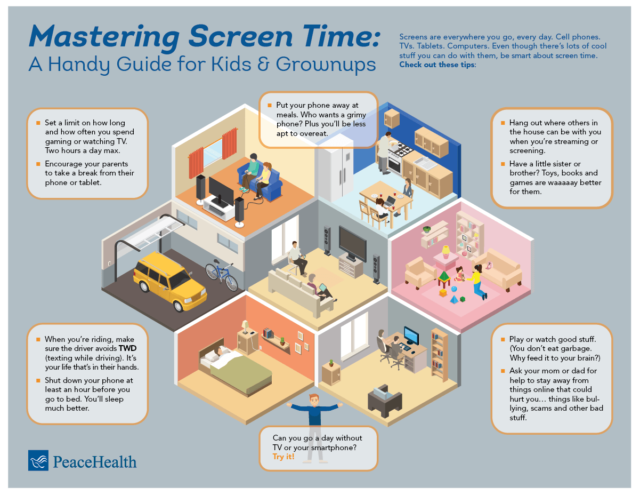In today’s digital age, learning to manage screen time effectively has become more crucial than ever. With screens all around us — from smartphones to laptops to tablets — it can feel like we’re constantly plugged in. But what if you could develop healthy tech habits that keep you connected without compromising your well-being? In this guide, we’ll explore proven strategies to help you manage screen time effectively, fostering digital wellness and preventing issues like digital fatigue and eye strain.
Understanding the Need to Manage Screen Time Effectively
Why Managing Screen Time Matters
We spend an increasing number of hours each day in front of screens. According to a study by Common Sense Media, adults in the U.S. average over 11 hours of screen time daily. That’s a lot of time spent looking at screens! This prolonged exposure can lead to digital fatigue, eye strain, poor posture, and even anxiety. By learning to manage screen time effectively, we can reduce these negative impacts and promote a healthier relationship with technology.
The Risks of Excessive Screen Time
Excessive screen time isn’t just a minor inconvenience; it poses several risks. Overuse of digital devices can cause digital eye strain, also known as Computer Vision Syndrome, leading to headaches, blurred vision, and dry eyes. In addition, constant exposure to blue light can disrupt our sleep patterns, contributing to insomnia. Managing screen time effectively is essential for maintaining not just our physical health, but our mental well-being as well.
Digital Wellness: Finding the Right Balance
Digital wellness is about striking the perfect balance between our online and offline lives. It’s not about eliminating screens completely — after all, technology plays a vital role in our modern world. Instead, it’s about being mindful of how we use our devices, adopting healthy tech habits that foster well-being, productivity, and connection.
Top Strategies to Manage Screen Time Effectively
1. Set Clear Boundaries for Screen Time
Creating boundaries is a powerful way to manage screen time effectively. Start by setting specific limits for how long you spend on different devices. For example, you might decide to spend no more than two hours a day on social media or establish a “no screens after 9 PM” rule.
How to Set Realistic Screen Time Goals
To set realistic goals, consider using screen time management tools. Most smartphones and tablets come with built-in features that track your usage. Review your data to identify which apps or activities consume the most time and set achievable goals to reduce them gradually.
Creating Tech-Free Zones
Designate certain areas of your home as tech-free zones. For instance, make your bedroom a no-screen zone to promote better sleep, or keep devices out of the dining room to encourage more meaningful conversations with family members. By setting these boundaries, you’ll manage screen time effectively while fostering healthier relationships.
Utilizing Parental Controls
If you’re managing screen time for kids, parental controls can be a great asset. Tools like Apple’s Screen Time or Google’s Family Link allow you to set daily limits on specific apps, monitor usage, and even approve or block new app downloads. Teaching children to manage screen time effectively from an early age will instill lifelong healthy tech habits.
2. Incorporate Breaks to Avoid Digital Fatigue
Taking regular breaks is essential for reducing digital fatigue and eye strain. The “20-20-20” rule is a simple and effective strategy: every 20 minutes, take a 20-second break and look at something 20 feet away. This helps relax the eye muscles and reduce discomfort from prolonged screen use.
The Importance of Microbreaks
Microbreaks, or short pauses throughout the day, can improve focus and prevent burnout. Set a timer to remind yourself to stand up, stretch, or walk around every hour. This not only reduces physical strain but also boosts productivity and creativity.
Scheduling Screen-Free Time
In addition to microbreaks, schedule longer screen-free periods during your day. This might mean stepping outside for a walk, practicing yoga, or simply closing your eyes and breathing deeply. By incorporating these mindful breaks, you’ll manage screen time effectively and improve your overall digital wellness.
Leveraging Digital Wellness Apps
There are several apps designed to encourage breaks and promote healthier tech habits. Apps like “BreakFree” and “Moment” offer reminders to take breaks, track your usage, and provide insights into your digital habits. By using these tools, you’ll be more aware of your screen time and more likely to manage it effectively.
3. Adjust Screen Settings for Comfort
Small adjustments to your device settings can make a big difference in managing screen time effectively. Start by tweaking brightness, contrast, and color settings to reduce eye strain. Many devices now offer “night mode” or “blue light filter” options that can help minimize the impact of screen glare.
Customizing Display Settings
Experiment with different display settings to find what works best for you. Lower the brightness in dimly lit environments and increase it in brighter settings. Adjusting text size and background color can also reduce eye strain, making screen use more comfortable.
Enabling Night Mode and Blue Light Filters
Many devices have features that reduce blue light exposure, such as “Night Shift” on iOS or “Night Light” on Android. These settings can be scheduled to activate automatically in the evening, helping to regulate your circadian rhythm and promote better sleep.
Using Screen Protectors and Glasses
Consider investing in screen protectors that reduce glare or blue light. Special computer glasses, like those with blue-light-blocking lenses, can also help reduce eye strain and protect your vision. These small changes contribute to a more comfortable screen experience and help manage screen time effectively.
4. Engage in Screen-Free Activities for Better Balance
To manage screen time effectively, it’s important to engage in activities that don’t involve screens. Prioritize hobbies that encourage movement, creativity, and social interaction. Whether it’s going for a walk, reading a book, or gardening, screen-free activities can help reset your focus and improve your overall well-being.
Discovering New Hobbies
Explore new interests that don’t involve technology. Join a local club, take up a sport, or learn a musical instrument. These activities provide a welcome break from screens and help manage screen time effectively.
Spending Time Outdoors
Nature is a powerful antidote to screen overload. Research from the American Psychological Association suggests that spending time in natural environments can reduce stress, improve mood, and enhance cognitive function. Make it a point to get outside regularly to balance your digital and non-digital life.
Socializing Without Screens
Make time for face-to-face interactions. Host a game night, plan a picnic, or have dinner with friends without the distraction of screens. These moments help strengthen relationships and remind us of the value of real-world connections.
5. Practice Digital Mindfulness for Lasting Wellness
Digital mindfulness involves being aware of how, when, and why you use technology. By practicing digital mindfulness, you become more intentional about your screen time and develop healthier tech habits.
Mindful Tech Use Practices
Practice mindfulness by regularly reflecting on your screen use. Notice when you’re using technology out of habit or boredom and ask yourself if it aligns with your goals. Set an intention before engaging with screens to ensure your tech habits are purposeful.
Mindfulness Apps and Tools
Use mindfulness apps that promote digital wellness. Apps like “Headspace” and “Calm” offer guided meditations and techniques to help you stay present and avoid unnecessary screen time.
Creating Mindful Tech Rituals
Establish rituals that promote digital mindfulness. This could be as simple as taking a deep breath before opening an app or setting aside time each day to meditate. These small practices help manage screen time effectively and enhance your overall well-being.
Take Control of Your Screen Time Today
Building a Healthier Relationship with Technology

Managing screen time effectively isn’t about quitting screens cold turkey; it’s about finding a balance that works for you. With these strategies, you can cultivate healthy tech habits that promote digital wellness, prevent digital fatigue, and reduce eye strain.
Start Small, Make Progress
Remember, change doesn’t happen overnight. Start by implementing one or two strategies at a time and gradually build up. Small steps lead to big changes, and soon you’ll find that managing screen time effectively becomes second nature.
Continue Your Journey Towards Digital Wellness
Explore more articles on our site to continue your journey towards digital wellness. Learn how to create a balanced digital life, discover the best apps for managing screen time, and find new ways to connect with the world around you — without a screen in sight.
For a visual representation of these tips, check out this infographic on screen time management. And for more expert advice, read this insightful piece from Harvard Business Review on Health and Wellness.
By following these steps, you can manage screen time effectively and enjoy a healthier, more balanced digital life.


